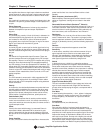
30 Chapter 3: Glossary of Terms
Amplifi er Application Guide
I
Load/
I
Limit Indicator
An indicator of some Crown amplifi ers that shows current fl ow
to the loudspeakers (“current load”) and the maximum cur-
rent available from the amplifi er (“current limit”). Typically, the
indicator will glow one color to indicate that current is fl owing
to the loads connected to the amplifi er output channel, and
change to another color to show that the amplifi er channel is
delivering its maximum output current.
Impedance
Impedance refers to the resistance of a circuit or device to AC
(alternating current). Most modern electronic audio devices
have extremely high input impedances so they can be driven
by very low power outputs. Impedance is measured in ohms.
The symbol Ω (omega) is often used to represent resistance.
Input
The connection going into an audio device. In a mixer or
mixing-console, a connector for a microphone, line-level
device, or other signal source.
Intermodulation Distortion (IMD)
Nonlinear distortion that occurs when different frequencies
pass through an amplifi er at the same time and interact to
create combinations of tones unrelated to the original sounds.
IMD specifi cations are usually expressed as a percentage of
the amplifi er’s output, and the lower the percentage the better.
IOC
®
The IOC (Input Output Comparator) circuit compares the
output signal of the amplifi er with the input signal. If there is
any difference other than gain, then it is considered distor-
tion and the indicator comes on. The LED indicator will come
on whenever there is distortion of 0.05% or more. This is a
dynamic Proof of Performance of the amplifi ers functionality.
Anytime you experience distortion in your system you can
view the IOC indicators. If they are not lit then you know that
the amplifi er is not at fault. If the IOC indicators are on, then
the amplifi er is in distortion.
To learn more about IOC, download and read the IOC white
paper at www.crownaudio.com.
Limiter
A limiter is a dynamics processor very similar to a compres-
sor. In fact, many compressors are capable of acting as limit-
ers when set up properly. The primary difference is the ratio
used in reducing gain. In a limiter, this ratio is set up to be as
close to infi nity:1 as possible (no matter how much the input
signal changes, the output level should remain pretty much
constant). The idea is that a limiter establishes a maximum
gain setting, and prevents signals from getting any louder
than that setting.
Line Level
Generally defi ned in the audio industry as +4 dBu (1.23 volts)
for balanced “pro” gear, and .316 volts (–10 dBV) for unbal-
anced “semi-pro” gear. “ It is best to match the levels of the
gear you are using so that –10 dBV equipment isn’t directly
feeding +4 dBu equipment, and vice versa. If you use gear of
both levels, there are various level matching devices on the
market to properly interface the items.
Linear Power Supply
A power supply that converts AC mains power for use by the
amplifi er by means of a conventional transformer operating at
the same frequency as that of the AC mains supply (usually
50 to 60 Hz).
Loudspeaker
A transducer that converts electrical energy (the signal) into
acoustical energy (sound waves).
Loudspeaker Offset Integration
A feature on some Crown amplifi ers that helps reduce output
clipping and off-center woofer cone movement caused by the
presence of large infrasonic (subaudible) frequencies. The
circuit adds a third order high-pass Butterworth fi lter with a –3
dB frequency of 35 Hz.
Low-Pass Filter
A fi lter that passes frequencies below a certain frequency and
attenuates frequencies above that same frequency. It can
also be called a high-cut fi lter.
Mic Level
The level (or voltage) of signal generated by a microphone.
Typically around 2 millivolts.
Negative Feedback
If some of the output of an amplifi er is made to be out of
phase, and mixed back with the amp’s input signal, it will
partially cancel the input, reducing the gain of the amplifi er;
this is called negative feedback. But, because it contains and
therefore cancels any distortion introduced by the amplifi er,
negative feedback also has the effect of improving the linear-
ity of the amplifi er. Negative feedback can also lower output
impedance, increasing damping factor, and can sometimes
be made to fl atten frequency response. The key to negative
feedback amplifi ers is careful design. Too much phase shift
and the amp will be unstable, and too much feedback will
cause Transient Intermodulation Distortion.
Noise
Unwanted sound, such as hiss from electronics or tape. An
audio signal with an irregular, non-periodic waveform.
Noise Floor
The noise fl oor of a device or system is the amount of noise
generated by the device itself with no signal present, it is
measured in decibels. All electronic devices will generate a
certain amount of noise, even a piece of wire! Minimizing the
noise fl oor leads to expanded dynamic range, and cleaner
recordings or sound production.
ODEP
®
ODEP (Output Device Emulator Protection) is an analog
computer simulation of the output device thermal imped-
ance. In layman’s terms ODEP stores how much power the
amplifi er delivers to its load and its heatsink temperature. If
the protection circuit determines that the output stage is being
overstressed or cannot dissipate any further heat, then output
stage drive is limited.
To learn more about ODEP, download and read the ODEP
white paper at www.crownaudio.com.
Output
A connector in an audio device from which the signal comes
and then feeds successive devices.
Overload
The distortion that occurs when an applied signal exceeds a
system’s maximum input level.
Parallel-Mono
As implemented in Crown amplifi ers, an operating mode of


















